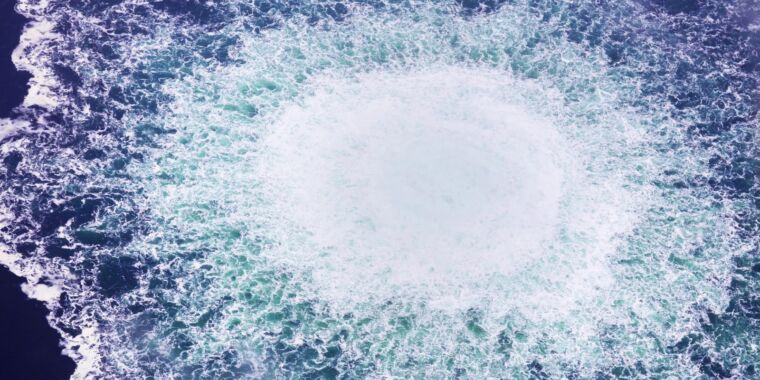
Swedish Coast Guard/Getty Images
The first gas leaks on the Nord Stream 2 pipeline in the Baltic Sea were discovered in the early hours of September 26, releasing up to 400,000 tons of methane into the atmosphere. Officials immediately suspected sabotage of the international pipeline. New analysis from WIRED shows that two large ships, with their trackers turned off, appeared around the spills in the days just before they were discovered.
According to the analysis by SpaceKnow, a satellite data monitoring company, the two “dark ships,” each about 95 to 130 meters in length, passed within a few miles of the Nord Stream 2 leak sites. “We have detected some dark ships, i.e. ships of considerable size, passing through that area of interest,” said Jerry Javornicky, the CEO and co-founder of SpaceKnow. “They had their beacons out, meaning there was no information about their movements, and they tried to hide their location and general information from the world,” added Javornicky.

The discovery, made by analyzing images from multiple satellites, is likely to fuel speculation about the cause of the blast. Multiple countries investigating the incident believe the Nord Stream 1 and 2 pipelines were rocked by a series of explosions, raising suspicions against Russia as the large-scale invasion of Ukraine continues. (Russia has denied involvement.) After SpaceKnow identified the ships, it reported its findings to NATO officials, who are investigating the Nord Stream incidents. Javornicky says NATO officials have asked the company for more information.
NATO spokesman Oana Lungescu said he would not comment on “details of our support or the sources used”, but confirmed that NATO believes the incident was a “deliberate and irresponsible act of sabotage” and that its presence in the Baltic Sea and the North Sea has enlarged . However, a NATO official, who was not authorized to speak publicly, confirmed to WIRED that NATO had received the data from SpaceKnow and that satellite imagery could be useful for its investigations.
To detect the ships, Javornicky says, the company searched 90 days of archived satellite images for the area. The company analyzes images from multiple satellite systems, including paid and free services, and uses machine learning to detect objects within them. This includes the ability to track roads, buildings and changes in landscapes. “We have 38 specific algorithms that can detect military equipment,” says Javornicky, adding that SpaceKnow’s system can detect specific aircraft models on runways.

